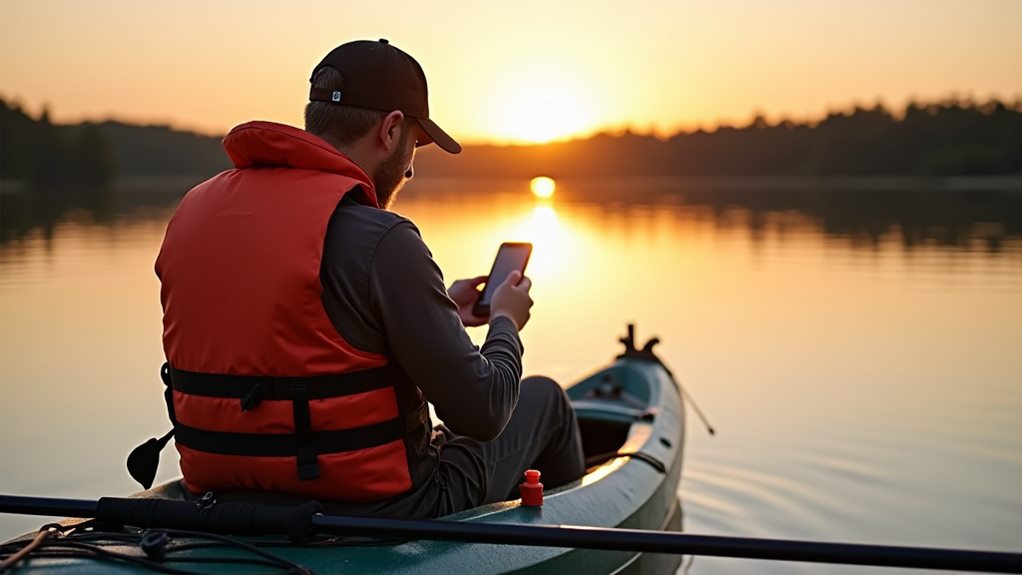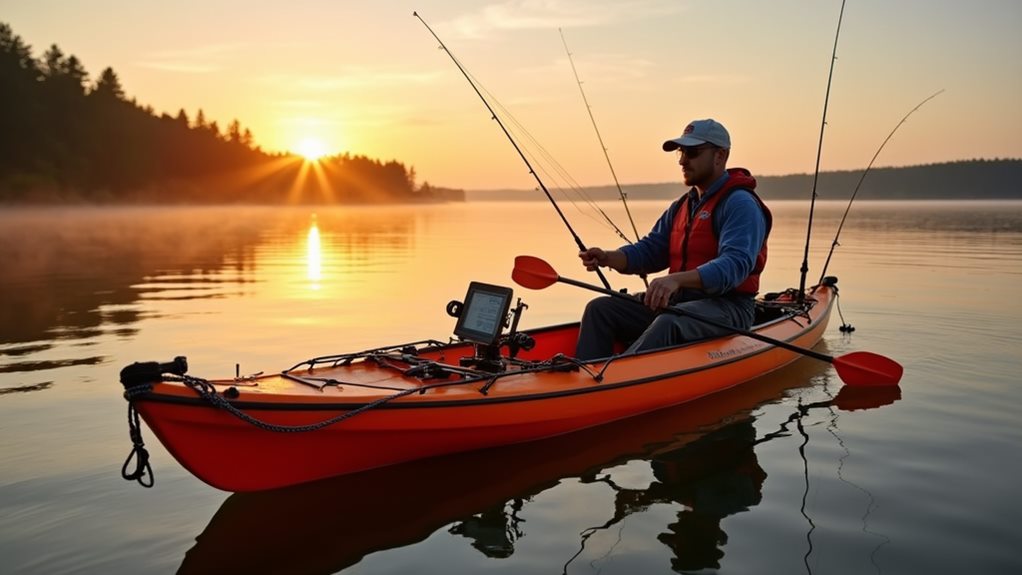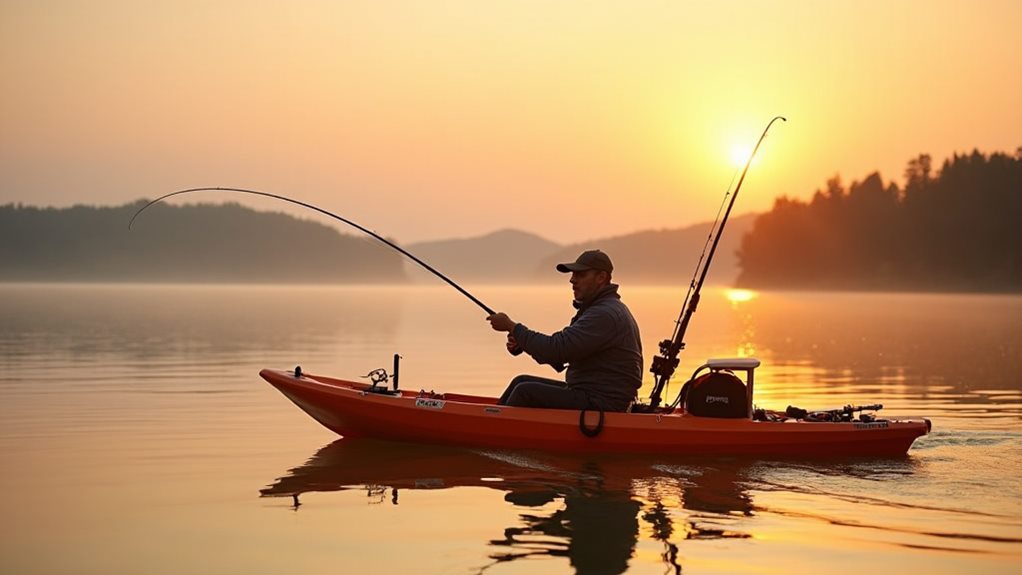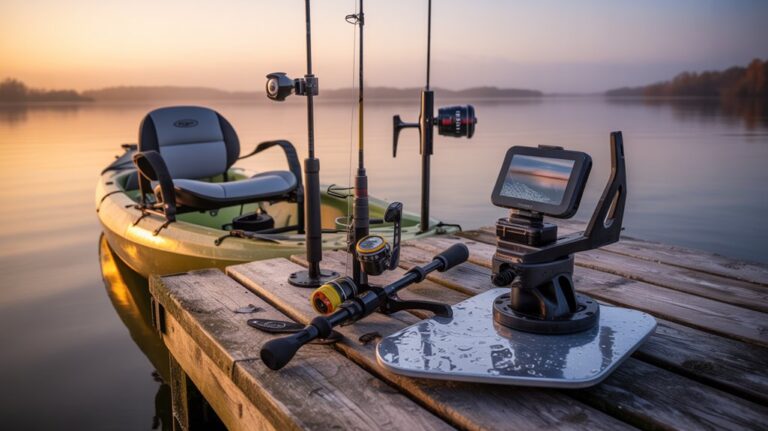Start your kayak fishing journey with safety as your top priority – always wear a properly fitting PFD and check weather conditions before launching. Choose a stable, sit-on-top kayak between 10-12 feet long, which offers the best balance of maneuverability and tracking. You'll need crucial gear like rod holders, dry storage, and a lightweight paddle. Master basic paddling techniques before focusing on fishing methods like drift fishing or trolling. Begin in calm waters like small lakes or ponds to build confidence. Stick to these fundamentals, and you'll be ready to discover the exciting world of advanced kayak fishing techniques.
Safety First on the Water

When you're heading out for a kayak fishing adventure, safety should be your top priority. The U.S. Coast Guard requires you to wear a PFD, so make sure you've got a personal flotation device that fits properly and won't restrict your fishing movements. Additionally, always carry a signaling device, such as a whistle or horn, for emergency communication vital gear for kayaking. Don't compromise on this vital piece of safety equipment – it could save your life if you unexpectedly end up in the water.
Before launching your kayak, check the weather forecast thoroughly. Strong winds and approaching storms can quickly turn a peaceful fishing trip into a dangerous situation. You'll want to avoid these conditions entirely. Always let someone know where you're planning to fish and when you expect to return – this information becomes significant if you need emergency assistance.
Keep a whistle attached to your PFD where you can reach it easily. This simple device can alert nearby boats if you need help. Don't forget to pack a thorough first aid kit with bandages, antiseptic wipes, and other basics to handle minor injuries. Store it in a waterproof container and place it somewhere accessible in your kayak, so you can quickly treat any cuts or scrapes that occur while fishing.
Choosing Your Perfect Kayak
Selecting the right kayak can make or break your fishing experience on the water. When choosing a kayak for fishing, you'll want to focus on stability and comfort as your top priorities. A 10-12 foot kayak offers the perfect balance between tracking and maneuverability, while wider models provide the stability you'll need, especially if you're planning to stand while fishing.
Sit-on-top fishing kayaks are your best bet as a beginner. They're easier to enter and exit, plus they offer plenty of storage space for your gear. Before making your purchase, always check the weight capacity to guarantee it'll support both you and your equipment safely.
| Feature | Benefit | Why It Matters |
|---|---|---|
| Width | Enhanced Stability | Prevents capsizing |
| Length | Better Control | Easier navigation |
| Storage | Gear Organization | Extended trips possible |
Don't rush your decision – take advantage of demo days or rental opportunities to test different models. You'll want to feel confident in your choice since you'll be spending hours on the water. Remember, the perfect kayak for you combines comfort, stability, and practical features that match your fishing style.
Essential Gear and Equipment

Now that you've got your kayak sorted, it's time to gear up for your fishing adventures. Your first priority should be a personal flotation device that fits snugly without restricting your movement. Don't compromise on this vital safety item, as it'll keep you protected while allowing comfortable paddling and fishing. Additionally, consider checking local regulations to guarantee compliance with fishing laws and safety standards, which can often vary by location and are significant for a successful outing fishing license requirements.
Select a lightweight paddle around 250 cm in length to guarantee efficient maneuverability without causing fatigue during long trips. You'll want to install rod holders on your kayak, which will let you paddle freely while keeping your fishing lines in the water. This hands-free setup is significant for managing multiple tasks on the water.
Protect your valuable gear by storing it in a dry bag, which will keep your tackle, electronics, and personal items safe from water damage. Don't forget to add an anchor system to your setup – a 10lb mushroom anchor will help you maintain position in currents or windy conditions, giving you better control for precise casting. This stability is especially important when you've found a promising fishing spot and need to stay put.
Basic Paddling Techniques
Mastering basic paddling techniques forms the foundation of successful kayak fishing. As a kayak angler, you'll need to develop efficient paddle strokes while wearing your personal flotation device to maintain control and conserve energy throughout your fishing session. It's crucial to understand how different kayak types can influence your paddling and fishing experience.
Start by perfecting the forward stroke, which you'll use most frequently. Focus on rotating your torso rather than just your arms to prevent fatigue and maximize power. When you need to stop or change direction quickly, employ the reverse stroke by pulling the paddle toward your kayak. This technique is particularly useful when approaching fishing spots or avoiding obstacles.
For maneuvering around structure or turning to follow fish, master the sweep stroke by moving your paddle in a wide arc away from your kayak. When you need to position yourself closer to docks or other fishing spots, use the draw stroke to move sideways. Remember to choose a paddle that's around 250 cm in length for ideal reach and control. This length allows you to maintain proper form while minimizing strain during extended fishing trips.
Fishing Methods From Kayaks

With your paddling skills established, it's time to focus on the primary fishing methods that work best from a kayak. When fishing from a kayak, you'll want to master three core techniques: drift fishing, trolling, and strategic casting.
Drift fishing lets you harness the natural current, allowing your bait to move naturally through the water while minimizing disturbance. You'll find this method particularly effective in rivers and streams. For trolling, paddle slowly while dragging your lure behind the kayak – this technique helps you cover more water and attract active fish species.
When casting from your kayak, focus on making low, quiet casts to avoid spooking fish. Practice your accuracy, as precise casting becomes vital when targeting specific structures. Understanding the aquatic terrain is important – look for submerged rocks, fallen trees, and vegetation edges where fish typically gather.
To maximize your success, employ specific rigging methods like Texas or Neko rigs, especially when targeting bass. These setups help you present your bait effectively while reducing snags in structure-heavy areas. Remember to adapt your technique based on the species you're targeting and the conditions you encounter.
Best Spots for Beginners
Selecting the right fishing spot makes all the difference when you're starting out with kayak fishing. Small lakes and ponds offer you the ideal environment to build confidence, as their calm waters make it easier to control your kayak while focusing on catching fish. You'll find these spots particularly welcoming when you're learning to balance fishing and paddling skills.
Local parks with designated kayak fishing areas should be at the top of your list of best spots for beginners. They're easily accessible and often maintain well-marked launch points, letting you concentrate on mastering your technique rather than worrying about navigation. If you're looking to expand your skills, try rivers with gentle currents where you can target bass and panfish while practicing your paddling.
Don't overlook estuaries and tidal creeks, as they provide excellent opportunities to catch various species while learning different fishing methods. Before heading out to any location, check local fishing reports to identify the most active fish species and ideal fishing times. This research will greatly improve your chances of success and help you make the most of your time on the water.
Frequently Asked Questions
How to Fish From a Kayak for Beginners?
You'll want to start with a stable sit-on-top kayak, master basic paddling strokes, and keep your gear simple. Secure everything with leashes, choose versatile lures, and always check local fishing regulations first.
How to Kayak Properly for Beginners?
Start with calm waters and maintain proper posture by aligning your head with the kayak's center. Keep your strokes smooth, using your core muscles to rotate. Don't forget to wear your PFD for safety.
What Is the Best Bait for Kayak Fishing?
You'll find soft plastics like Texas-rigged worms and jigs are your best kayak fishing baits. Don't forget topwater lures for dawn/dusk, and live bait like minnows when you're targeting multiple species.
Do Fishing Kayaks Tip Easily?
No, fishing kayaks don't tip easily. You'll find they're designed with wide, stable hulls. If you maintain proper balance, secure your gear, and use controlled movements, you'll stay upright during your fishing adventures.
Final Thoughts
You're now equipped with the key knowledge to start your kayak fishing journey. Remember to prioritize safety, invest in the right equipment, and practice your paddling skills before tackling more challenging waters. Start in calm, familiar spots and you'll build confidence quickly. Don't be afraid to learn from experienced kayak anglers – they've all been beginners too. Get out there and enjoy this exciting sport!




